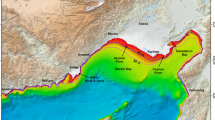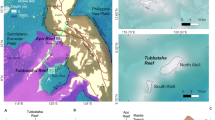Abstract
Shoreline changes are largely dependent on coastal morphology. South-west coast of India is a high energy coast characterised by monsoon high waves, steep beach face and medium-sized beach sand. Waves are generally from west and west south-west during rough monsoon season and from south-west during fair weather season. Shoreline change along this coast is studied with reference to coastal morphological features. Various morphological features, modifications and chronological positions of shoreline are analysed with the information derived from multidated satellite imageries, toposheets and GPS shoreline mapping along with extended field survey. Image processing and GIS techniques have been used for the analysis of data and presentation of results. Sediment accumulation on the leeward side of artificial structures such as harbour breakwaters and groynes is used as a sediment transport indicator. Artificial structures such as seawalls, groynes and harbour breakwaters modify morphology. Shoreline south of headlands/promontories and breakwaters are stable or accreting due to net northerly longshore sediment transport while erosion tendency is observed on the north side. Lateritic cliffs fronting the sea or with seasonal beach undergo slumping and cliff edge retreat as episodic events. Spits adjoining tidal inlets are prone to shoreline variations due to oscillations of inlet mouth. Interventions in the form of inlet stabilization and construction of coastal protection structures trigger erosion along adjoining coasts. Seawalls constructed along highly eroding coasts get damaged, whereas those constructed along monsoon berm crest with frontal beaches for protection against monsoon wave attack are retained. Fishing gaps within seawalls are areas of severe temporary erosion during rough monsoon season. Accretion or erosion accompanies construction of harbour breakwaters in a stable coastal plain. Close dependence of shoreline changes on morphology necessitates detailed understanding of impacts on morphology prior to introducing any intervention in the coastal zone.
















Similar content being viewed by others
References
Ajeesh NR (2011) Shoreline response of sandy coast to coastal protection measures, a numerical modeling approach. M Tech thesis, National Institute of Technology, Karnataka, India
Ali TA (2003) New methods for positional quality assessment and change analysis of shoreline features. Ohio State University, Columbus, p 156
Baba M, Kurian NP (1988) Instrumentation, data collection and analysis for wave and beach studies. In: Baba M, Kurian NP (eds) Ocean waves and beach processes. National Centre for Earth Science Studies, Thiruvananthapuram, pp 15–45
Baba M, Shahul Hameed TS, Kurian NP, Thomas KV, Harish CM, Rameshkumar M, Mohahanan S (1984) Long-term wave and beach data of Kerala coast. National Centre for Earth Science Studies, Thiruvananthapuram
Baba M, Kurian NP, Shahul Hameed TS, Thomas KV, Harish CM (1987) Temporal and spatial variation in wave climate off Kerala, Southwest coast of India. Indian J Geo Mar Sci 16:5–8
Baba M, Mathai John, Muralidas S, Sankar G, Chattopadyay S, Sukumar B, Kurian NP, Samsuddin M (2009) Thiruvananthapuram district map in multiple hazard zonation map of Kerala. Centre for Earth Science Studies, Thiruvananthapuram
Bakker WT, Klein Breteler EAJ, Roos A (1970) The dynamics of a coast with a groin system. In: Proceedings. 12th conference on coastal engineering, pp 1001–1020
Chaaban F, Darwishe H, Battiau-Queney Y, Louche B, Masson E, El Khattabi J, Carlier E (2012) Using Arc-GIS model builder and aerial photographs to measure coastline retreat and advance: North of France. J Coast Res 28(6):1567–1579
Chattopadhyay S, Sasidharan CK, Mathai J (2004) Concept and application of panchayat resource mapping. In: Ravindra Kumar GR, Subash N (eds) Earth system science and natural resource management. Centre for Earth Science Studies, Thiruvananthapuram, pp 401–415
Cuadrado DG, Gomez EA, Ginsberg SS (2005) Tidal and longshore sediment transport associated to a coastal structure. Estuar Coast Shelf Sci 62:291–300
Dolan R, Hayden B, Heywood J (1978) A new photogrammetric method for determining shoreline erosion. Coast Eng 2:21–39
Galgano FA (2009) Beach erosion adjacent to stabilized micro tidal inlets. Middle States Geogr 42:18–32
Kim HJ, Hwan J, Woo KJ (2009) A new methodology for measuring coastline recession using buffering and non-linear least squares estimation. Int J Geogr Inf Sci 23(9):1165–1177
Komar PD (1998) Beach processes and sedimentation, 2nd edn, vol 347. Prentice Hall Inc., Upper Saddle River, New Jersey, p 544
Kumar VS, Deo MC (2004) Design wave estimation considering directional distribution of waves. Ocean Eng 31:2343–2352
Kurian NP (1987) Wave height and spectral transformation in the shallow waters of Kerala coast and their prediction. Ph.D Thesis, Cochin University of Science and Technology, Cochin
Kurian NP, Baba M (1987) Wave attenuation due to bottom friction across the southwest Indian continental shelf. J Coast Res 3(4):485–490
Kurian NP, Nirupama N, Baba M, Thomas KV (2008) Coastal flooding due to synoptic scale mesoscale and remote forcings. Nat Hazards 48(2):259–273
Li R, Liu JK, Felus Y (2001) Spatial modeling and analysis for shoreline change detection and coastal erosion monitoring. J Mar Geod 24(1):1–12
ASR Limited (2010) Multi-purpose Reef at Kovalam, Kerala, Project completion report. Government of Kerala, India
Liu JK (1998) Developing geographic information system applications in analysis of responses to Lake Erie shoreline changes. Ohio State University, Columbus, p 133
Machado T, Baba M (1984) Movement of beach sand in the Vizhinjam bay, West coast of India. Indian J Geo Mar Sci 13:144–146
Moni NS (1970) Systematic study of coastal erosion and defence works in the southwest Coast of India. In: Proceedings of the 13th conference coastal engineering ASCE, Washington. pp 1427–1450
National Centre for Sustainable Coastal Management (NCSCM) (2011) Shoreline change assessment for Kerala coast. Fact sheet, p 6
Noujas V, Thomas KV (2015) Erosion hotspot along southwest coast of India. Aquatic procedia 4:548–555
Noujas V, Thomas KV, Sheela Nair L, Hameed TSS, Badarees KO, Ajeesh NR (2014) Management of shoreline morphological changes consequent to breakwater construction. Indian J Geo Mar Sci 43(1):54–61
Noujas V, Thomas KV, Ajeesh NR (2017) Shoreline management plan for a protected but eroding coast along the southwest coast of India. Int J Sedim Res. https://doi.org/10.1016/j.ijsrc.2017.02.004 (Forthcoming)
Sajeev R, Chandramohan P, Josanto V, Shankaranarayan VN (1997) Studies on sediment transport along Kerala coast, south west coast of India. Indian J Geo Mar Sci 26:11–15
Shaji J (2014) Coastal sensitivity assessment for Thiruvananthapuram, west coast of India. Nat Hazard 73:1369–1392
Shamji VR, Shahul Hameed TS, Kurian NP, Thomas KV (2010) Application of numerical modelling for morphological changes in a high-energy beach during the south-west monsoon. Curr Sci 98(5):691–695
Sreekala SP, Baba M, Muralikrishna M (1998) Shoreline changes of Kerala coast using IRS data and aerial photographs. Indian J Geo Mar Sci 27:144–148
Srivastava A, Niu X, Di K, Li R (2005) Shoreline modeling and erosion prediction. In: ASPRS 2005 annual conference, Baltimore, p 11
Thomas KV (1988) Waves and nearshore processes in relation to beach development at Valiathura. In: Baba M, Kurian NP (eds) Ocean waves and beach processes. Centre for Earth Science Studies, Thiruvananthapuram, pp 47–56
Thomas KV, Baba M (1986) Berm development on a monsoon influenced micro tidal beach. J Sedim 33:537–546
Thomas KV, Baba M, Harish CM (1986) Wave groupiness in long travelled swell. J Waterw Port Coast Ocean Eng 112(4):498–511
Thomas KV, Kurian NP, Sundar V, Sannasiraj SA, Badarees KO, Saritha VK, Abhilash S, Sarath LG, Srikanth K (2010) Morphological changes due to coastal structures along the southwest coast of India. In: Proceedings, Indo-Brazil Workshop, pp 125–133
Thomas KV, Kurian NP, Shahul Hameed TS, Sheela Nair L, Srinivas R (2013) Shoreline management plan for selected location along Kerala coast. Report submitted to ICMAM Project Directorate, MoES. Centre for Earth Science Studies, Thiruvananthapuram, p 308
Zhang K, Douglas BC, Leatherman SP (2004) Global warming and coastal erosion. Clim Change 64:41–58
Acknowledgements
We thank Director, National Centre for Earth Science Studies (NCESS) for providing the facilities. The support provided by Ajeesh N. R., Sreekanth K., Vimal K. C., Badarees K.O., and other colleagues in the Marine Science Division of NCESS is gratefully acknowledged. Support of Dr. R. S. Kankara, Scientist F and Group Head, Coastal Processes and Shoreline Mapping Group, ICMAM PD in facilitating certain parts of the study under Shoreline Management Plan project is greatly acknowledged.
Author information
Authors and Affiliations
Corresponding author
Rights and permissions
About this article
Cite this article
Thankappan, N., Varangalil, N., Kachapally Varghese, T. et al. Coastal morphology and beach stability along Thiruvananthapuram, south-west coast of India. Nat Hazards 90, 1177–1199 (2018). https://doi.org/10.1007/s11069-017-3090-1
Received:
Accepted:
Published:
Issue Date:
DOI: https://doi.org/10.1007/s11069-017-3090-1




